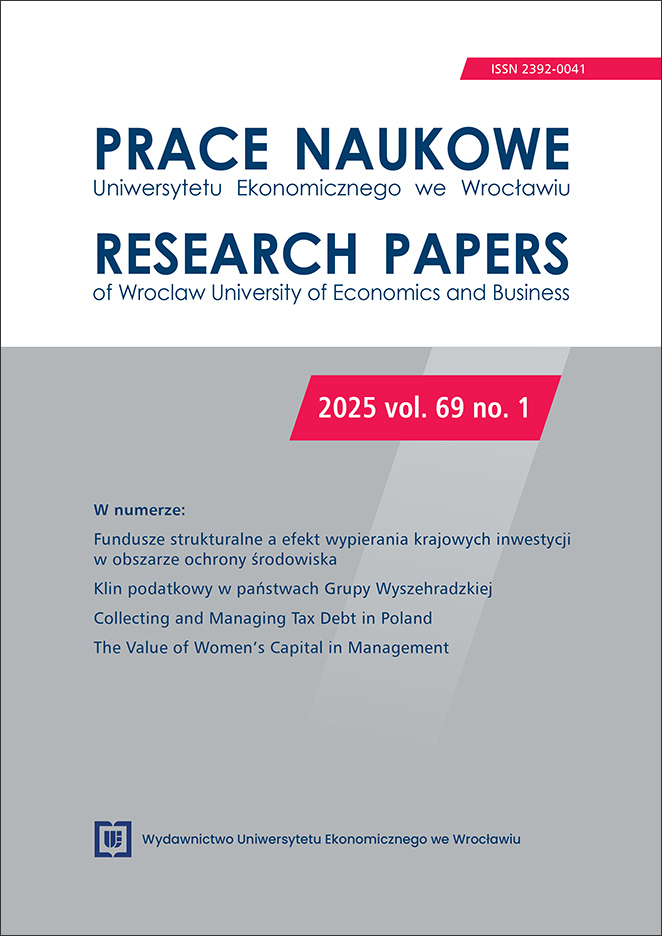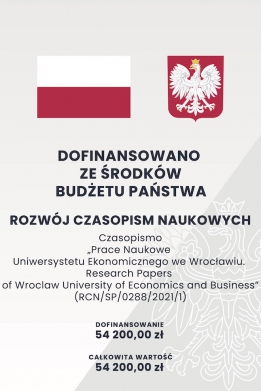Tax Reliefs for Innovation after the Polish Deal − An Attractive Solution for Polish Entrepreneurs? A Pilot Study
DOI:
https://doi.org/10.15611/pn.2025.1.05Keywords:
innovation, tax reliefs, Polish entrepreneurs, the Polish DealAbstract
Aim: On 1 January 2022, “The Polish Deal” policy introduced a number of new tax reliefs regarding robotization, innovative employees and prototypes, which supplemented the current system of incentives for innovation and amended those already existing (R&D relief and IP Box). The aim of the article was to verify the attitudes of Polish entrepreneurs towards the introduced legislative changes and to identify barriers in their application.
Methodology: In order to achieve the research goal, literature and questionnaire-based pilot studies were carried out. The respondents were asked questions concerning their innovation activities, tax incentives already used and planned by them for the future, as well as their opinions about the discussed tax reliefs and the barriers in their application. The authors used the 5-point Likert scale.
Results: The research results demonstrated that the introduction of tax reliefs was assessed by the respondents as a positive phenomenon; however, the shape of the regulations implemented in 2022 did not encourage the vast majority entrepreneurs to apply them in practice.
Implications and recommendations: The provisions introduced so far have significant potential for improvement in terms of the degree of their precision, transparency and requirements related to their application. On the other hand, frequent changes in tax law inhibit the development of innovative activity, therefore the new regulations should not only be transparent and precise but also stable, and designed to be long-lasting.
Originality/value: The empirical research on attitudes of Polish enterprises towards tax reliefs for innovation after the legal changes in 2022 fills the research gap in this area.
Downloads
References
Al Fozaie, T. M. (2023). Behavior, Religion, and Socio-economic Development: A Synthesized Theoretical Framework. Humanities and Social Sciences Communications, 10, 1–15.
Allen, P., Robinson, M., Butans, E., & Varga, L. (2019). Innovations for Sustainable Lifestyles: An Agent-Based Model Approach. Sustainability Science, 14(2), 341–354.
Babbie, E. (2008). Podstawy badań społecznych. PWN.
Białek-Jaworska, A., Teterycz, A., Sichel, R., & Woźniak, M. (2023). IP Box Effects in the Gaming Industry. Central European Management Journal, 31(3), 291–325.
Białek-Jaworska, A., Budlewska, R., & Hałatek, E. (2024). R&D Tax Allowance and Voluntary Information Disclosures. Zeszyty Teoretyczne Rachunkowości, 48(2), 9–36.
Bloom, N., Griffith, R., & Van Reenen, J. (2002). Do R&D Tax Credits Work? Evidence from a Panel of Countries 1979–1997, Journal of Public Economics, 85(1), 1–31.
Brown, J. R., Martinsson, G., & Petersen, B. C. (2017). What Promotes R&D? Comparative Evidence from around the World. Research Policy, 46, 447–462.
Cappelen, A., Raknerud, A., & Rybalka, M. (2012). The Effects of R&D Tax Credits on Patenting and Innovations. Research Policy, 41(2), 334–345.
Carboni, O. A. (2017). The Effect of Public Support on Investment and R&D: An Empirical Evaluation on European Manufacturing Firms. Technological Forecasting and Social Change, 117, 282–295.
Chen, G., & Breedlove, J. (2020). The Effect of Innovation-Driven Policy on Innovation Efficiency: Based on the Listed Sports Firms on Chinese New Third Board. International Journal of Sports Marketing and Sponsorship, 21(4), 735–755.
Crespi, G., Giuliodori, D., Giuliodori, R., & Rodriguez, A. (2016). The Effectiveness of Tax Incentives for R&D in Developing Countries: The Case of Argentina. Research Policy, 45(10), 2023–2035.
Czarnitzki, D., Hanel, P., & Rosa, J. M. (2011). Evaluating the Impact of R&D Tax Credits on Innovation: A Microeconometric Study on Canadian Firms. Research Policy, 40(2), 217–29.
Dai, X., & Wang, M. (2024). Unintended Effects of Tax Incentives on Firms’ Strategic Patenting. Journal of Economic Behavior & Organization, 219(2), 1–24.
Filser, M., De Massis, A., Gast, J., Kraus, S., & Niemand, T. (2018). Tracing the Roots of Innovativeness in Family SMEs: The Effect of Family Functionality and Socioemotional Wealth. Journal of Product Innovation Management, 35(4), 609–628.
GUS. (2020). Podręcznik Oslo 2018, Zalecenia dotyczące pozyskiwania, prezentowania i wykorzystywania danych z zakresu innowacji (4th ed.). GUS. https://stat.gov.pl/obszary-tematyczne/nauka-i-technika-spoleczenstwo-informacyjne/ nauka-i-technika/podrecznik-oslo-2018,18,1.html
Hewitt-Dundas, N. (2006). Resource and Capability Constraints to Innovation in Small and Large Plants. Small Business Economics, 26, 257–277.
Janiszewska, M., & Janiszewski, J. M. (2020). Wykorzystanie regulacji podatkowych w działalności innowacyjnej polskich przedsiębiorców. Studia BAS, 1(61), 51–73.
Janiszewska, M., & Janiszewski, J. M. (2024). Ulgi podatkowe jako narzędzie wspierania konkurencyjności polskich przedsię-biorstw. Studia BAS, 1(77), 29–52.
Kang, K. N., & Park, H. (2012). Influence of Government R&D Support and Inter-Firm Collaborations on Innovation in Korean Biotechnology SMEs. Technovation, 32(1), 68–78.
Lee, D. (2018). Impact of the Excise Tax on Firm R&D and Performance in the Medical Device Industry: Evidence from the Affordable Care Act. Research Policy, 47(5), 854–871.
Li, H., Zhang, J., Wang, C., Wang, Y., & Coffey, V. (2018). An Evaluation of the Impact of Environmental Regulation on the Efficiency of Technology Innovation Using the Combined DEA Model: A Case Study of Xi’an, China. Sustainable Cities and Society, 42, 355–369.
Mukherjee, A., Singh, M., & Žaldokas, A. (2017). Do Corporate Taxes Hinder Innovation? Journal of Financial Economics, 124(1), 195–221.
Niewiadomski, P., & Nogalski, B. (2023). Ulga podatkowa jako forma wsparcia procesów zarządzania i rozwoju innowacyjnych przedsiębiorstw – struktura i zakres jej wykorzystania wśród producentów części i podzespołów technicznych środków transportu rolniczego. Zeszyty Naukowe Politechniki Poznańskiej. Organizacja i Zarządzanie, 87, 103–125.
PARP. (2023a). Raport o stanie sektora małych i średnich przedsiębiorstw w Polsce. PARP. https://www.parp.gov.pl/storage/publications/pdf/ROSS_2023_scalony_ost_popr.pdf
PARP. (2023b). Monitoring innowacyjności polskich przedsiębiorstw. Wskaźnik dojrzałości innowacyjnej – 2023. Raport końcowy z badań. PARP. https://www.parp.gov.pl/component/publications/publication/monitoring-innowacyjnosci-polskich-przedsiebiorstw-wskaznik-dojrzalosci-innowacyjnej---2023
Piotrowska, K., & Wanicki, P. (2023). Factors Affecting the Use of Tax Preferences for Research and Development in Poland. Optimum. Economic Studies, 4(114), 133–152.
Poznańska, K. (2009). Innowacyjność przedsiębiorstw. In I. Lichniak (Ed.), Nauka o przedsiębiorstwie. Wybrane zagadnienia. (pp. 333–334). Wydawnictwo SGH.
Raczkowski, K., Schneider, F., & Węgrzyn, J. (2020). Ekonomia systemu podatkowego. PWN.
Samad, K. A., Rahman, N. H. A., & Roseli, N. H. M. (2019). Tax Perceived as a Barrier to Innovation. International Journal of Recent Technology and Engineering, 8(2S), 493–497.
Sopińska, A., & Wachowiak, P. (2016). Innovativeness of Enterprises Operating in Poland. Przegląd Organizacji, 5, 17–23.
Susskind, D. (2020). A World Without Work: Technology, Automation, and How We Should Respond. Metropolitan Books.
Ścigała, M. (2016). Innowacyjność jako cecha organizacji – systematyzacja i konceptualizacja. Zeszyty Naukowe. Organizacja i Zarządzanie, 96, 193–204.
Ustawa z dnia 26 lipca 1991 r. o podatku dochodowym od osób fizycznych (Dz.U.2024.863).
Ustawa z dnia 15 lutego 1992 r. o podatku dochodowym od osób prawnych (Dz.U.2024.854).
Walter, C. E., Au-Yong-Oliveira, M., Veloso, C. M., & Polónia, D. F. (2022). R&D Tax Incentives and Innovation: Unveiling the Mechanisms behind Innovation Capacity. Journal of Advances in Management Research, 19(3), 367–388.
Wang H., Chenb X., Chenb J., Xu Ch. (2025), Tax Incentives, Confidence, and Enterprise Innovation in Chinese Listed Com-panies, Emerging Markets Finance and Trade, 61(1), 241–255.
Watkins A., Papaioannou T., Mugwagwa J., Kale D. (2015). National Innovation Systems and the Intermediary Role of Industry Associations in Building Institutional Capacities for Innovation in Developing Countries: A Critical Review of the Literature, Research Policy, 44, 1407–1418
Wu, Y. J., Goh, M., & Mai, Y. (2023). Social Innovation and Higher Education: Evolution and Future Promise. Humanities and Social Sciences Communications, 10(283), 1–14.
Yue, Z., Yang, G., & Haisen, W. (2023). How Do Tax Reductions Motivate Technological Innovation? Humanities and Social Sciences Communications, 10(1), 1–18.
Zbroińska, B. A. (2021). Instrumenty podatkowe wspierające innowacje i nowe inwestycje polskich przedsiębiorstw. Optimum. Economic Studies, 2(104), 71–81.
Zee, H. H., Stotsky, J.G., & Ley, E. (2002). Tax Incentives for Business Investment: A Primer for Policy Makers in Developing Counties. World Development, 30(9), 1497–516.
Downloads
Published
License
Copyright (c) 2025 Magdalena Janiszewska, Jan M. Janiszewski

This work is licensed under a Creative Commons Attribution-ShareAlike 4.0 International License.
Accepted 2025-02-12
Published 2025-04-14









